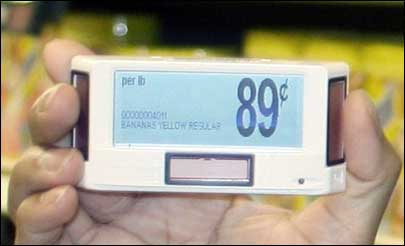Two U.S. grocery-store chains are trialing an electronic shelf label (ESL) system in several of their stores on the East and West coasts. The ESL system, provided by Altierre, comprises RFID-based LCD displays that attach to store shelves to identify products and their prices, enabling immediate shelf-side updates of product data. The system can be managed from a remote location and help the stores avoid using millions of paper labels annually. According to Sunit Saxena, Altierre’s chairman and CEO, the system has been six years in the making, and has been piloted for the past nine months.
Altierre also opened a retail technology center at its headquarters building in San Jose, Calif. The center, consisting of a supermarket and technology lab, enables potential RFID technology users to test the system in a simulated environment.
Altierre began developing a labeling solution for retailers in 2003, Saxena says. The company sought to create a solution that would allow retailers to instantaneously update, from a centralized location, the information they display to customers regarding the food, electronics, clothing or other products they sell. A typical chain retailer makes 10,000 to 12,000 price changes each week, Saxena notes, and creating shelf labels to reflect those many changes requires printing paper labels and using staff labor to attach them to the shelves. Mistakes often result during that process, and the number of price changes and shelf-labeling errors are both on the rise.
“Stores just can’t keep up with fast price changes,” Saxena states, describing the challenges retailers face when using paper labels. Although point-of-sale data is updated electronically so that the price charged to customers can be changed automatically at the cash register, he says, the shelf has always been removed from that electronic data stream.
Altierre considered a Wi-Fi-based solution, Saxena says, but found that each Wi-Fi node could not support a sufficient quantity of tags. Wiring electronic tags was also not feasible, he adds, since shelving fixtures are often moved, requiring the rewiring of electronic shelf labels. As the company considered radio frequency identification, it did not find any existing technology that met its requirements.
“We found no chip existed to meet the cost needs, the low power requirements or the read range we wanted,” Saxena explains. So the company developed its own 2.4 GHz RFID chip with a proprietary air-interface protocol for use in its electronic shelf label, which also contains a coin battery and a chip that controls the label’s LCD screen. Each label’s RFID chip stores the product’s stock-keeping unit (SKU) number, name, price and other information.
The two retailers, which decline to be named, have installed Altierre’s RFID readers in the ceilings of each participating store. The company set up a computer server in each store’s back room, to receive pricing updates from the retailers’ headquarters via an Internet connection. The server sends those changes to the interrogators via an Ethernet cable, and the readers transmit the new information to the appropriate shelf labels. Upon receiving the instructions, the labels immediately update the product information on the LCD screen, as well as sending a confirmation to the interrogators indicating the transmission’s reception.
With the system, Saxena says, a store can update the product information displayed on 10,000 labels in less than an hour. The stores piloting the system have typically installed two RFID readers to control 25,000 shelf labels deployed across a sales floor measuring 50,000 square feet in size.
In addition, store employees can use a handheld interrogator, also designed by Altierre, to cause the data displayed on the labels’ LCD to switch from customer information (such as pricing) to data such as bar-coded SKU numbers that might be utilized to order additional inventory. The handheld can be used to “flip” that information on a particular aisle, or throughout the entire store.
The Altierre software also enables stores to facilitate recalls by sending them recall data associated with a particular product’s SKU number. The specific labels for that recalled product will then flash a recall alert on the display in bold lettering, immediately warning customers to not purchase that item.
The first store began piloting the system approximately nine months ago, Saxena says, and the rest have installed their systems during the past few months. “It seems to be working fine,” he states. The labels, which cost about $5 apiece and need to be replaced every five years, should provide a 100 percent return on investment within one and a half to two years, Saxena says.
According to Saxena, the stores have been working closely with Altierre throughout the development stage, and the pilots will continue before any further deployments are planned. “We’ll spend more time on piloting, and let the chains feel their comfort level,” Saxena says, adding that he expects Altierre to market the system in North America, Europe and Japan.
Retailers, including those piloting Altierre’s system, are currently studying the system at the company’s retail technology center, which opened this month. The center consists of a replica of a 25,000-square-foot supermarket, as well as an adjacent 20,000-square-foot technology lab. The store is equipped with a server and RFID readers, in addition to more than 10,000 electronic shelf labels along the store aisles. The center also includes refrigerated and freezer sections for testing the labels in cold temperatures.
“We will use [the center] to test new technologies and applications under a real-world retail environment,” Saxena says, “and we will invite other companies—our retail partners, other startups—to use it as a proving ground for testing and developing their products.”



